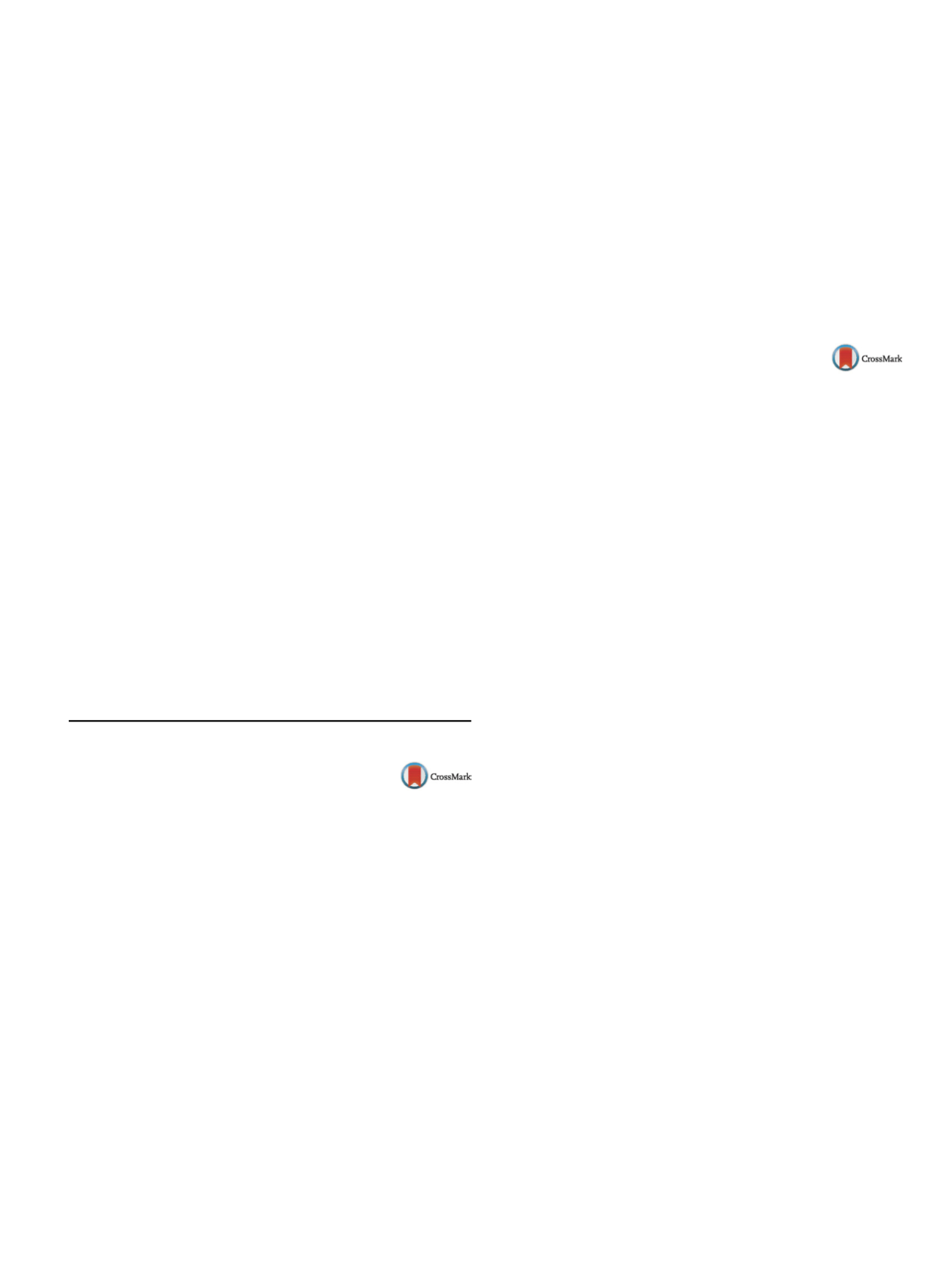

25th European Congress of Psychiatry / European Psychiatry 41S (2017) S170–S237
S219
Risperidone, atypical antipsychotics, was approved for irritability
in autistic disorder. However, some patients hadminimal improve-
ment or no response to this treatment. The purpose of this study
was to evaluate the association of pharmacogenomics factors
and clinical outcomes in autistic children and adolescence who
treated with risperidone for long periods. Sixty-seven autistic sub-
jects diagnosed with DSM-IV criteria and treated with risperidone
more than 1 year were evaluated clinical symptom by CGI, aggres-
sive, over activity, and repetitive score. Polymorphisms of ABCB1,
CYP2D6, DRD2, DRD3, and HTR2A were analyzed. Almost patients
showed stable symptom on aggressive (91.04%), over activity
(73.13%), repetitive (68.25%) behavior, and all clinical symptoms
(82.09%). Only 4.48% of patients showed minimally worse on CGI-I
score. Patients in non-stable of all symptomgroup had DRD2 Taq1A
non-wildtype (TT and CT) frequencies higher than clinical stable
group (
P
= 0.046), whereas other genes polymorphism showed no
significant association. Interestingly, there was no patient with
HTR2A-1438G > A wildtype in all non-stable symptoms. However,
there was no significant association due to small sample sizes. Drug
levels (RIS, 9OH-RIS, and active moiety) did not show the associa-
tionwith any clinical outcome. Increased appetitewas the common
ADRs, which associated with high body weight, whereas there was
not significantly associatedwith genetic variations and non-genetic
information. In conclusion, risperidone showed efficacy to con-
trol autism, especially aggressive symptom in long-term treatment.
However, dopamine 2 gene variation affect to non-stable in risperi-
done treated patients. This study supports pharmacogenomics
testing for personalized therapeutics of risperidone in autistic
disorder.
Disclosure of interest
The authors have not supplied their decla-
ration of competing interest.
http://dx.doi.org/10.1016/j.eurpsy.2017.01.2203e-poster walk: Child and adolescent
psychiatry–Part 4
EW0334
Psychiatric disorders run in families.
Children of parents with serious
mental disorders: A case history
M.D. Ortega Garcia
1 ,∗
, M.V. Marti Garnica
1, S. Garcia Marin
2,
C. Martinez Martinez
3, R. Gomez Martinez
3, P. Blanco del Valle
4,
M.A. Lopez Bernal
51
CSM Cartagena, Child and Adolescent Mental Health Centre,
Cartagena, Spain
2
CSM Lorca, Psychiatry, Lorca, Spain
3
CSM Leon, Psychiatry, Leon, Spain
4
CSM Soria, Psychiatry, Soria, Spain
5
Psychiatry, CSM Cartagena, Cartagena, Spain
∗
Corresponding author.
Aims/method
Publications and studies have shown that the exist-
ence of serious mental disorders in parents is a risk in the
development of children and is more common the existence of
mental illness in them than in the general pediatric population.
This work aims to reflect in depth on the study of the influence
of psychotic parents on child development through a review of a
clinical study. We present the case of 14 years old adolescent who
is being treated in a mental health center, whose parents suffers
from a severe mental illness. We also defend the importance of a
preventive approach or treatment that impinges on the child and
family environment.
Results/conclusions
A way of community work, in coordination
with the different teams (social services, educational services, etc.)
allows more efficient and appropriate treatment, using various
resources. When risk factors for developing mental health prob-
lems in childhood, family history and especially the existence of one
or both parents of mentally pathology type schizophrenia or other
psychoses are studied become important. It seems essential to
address as a priority to the social group have called “high-risk group
of psychosis’, and in particular to the” sons of patients diagnosed
with psychosis”, both for its size and the severity and chronicity of
psychopathology if developing means for early psychosocial care
does not occur.
Disclosure of interest
The authors have not supplied their decla-
ration of competing interest.
http://dx.doi.org/10.1016/j.eurpsy.2017.01.2204EW0335
Kaufman brief intelligence test
analysis of its usefulness in children
population for the assessment of
intelligence quotient (IQ)
M. Palomo Monge
1 ,∗
, J.F. Calvo Mauri
2, M.D.C. Romo Barrientos
2,
M.F. Alcocer Lanza
31
Psychiatry, 45600, Spain
2
Psychiatry, Hospital Nuestra Se˜nora del Prado, 45600, Spain
3
Family and community medicine, Hospital Nuestra Se˜nora del
Prado, 45600, Spain
∗
Corresponding author.
Introduction
The determination of IQ is essential in the assess-
ment and diagnosis of children. There are multitude of tests, one of
the most used are the Wechsler Scales.
Aims
Hypothesis: Assessment of IQ is equivalent using theWech-
sler Intelligence Scale for Children-Revised (WISCr) and Kaufman
inteligence brief test (KBIT).
Subjects Children undergoing treatment at Unit Child and Ado-
lescent Mental Health of Talavera with determination IQ at some
point in the intervention: 39 pairings determination of IQ sub-
jects atended: 20 males and 19 females, aged between 4 and
14 years.
Material
Subjects are evaluated with KBIT and WISCr tests.
Methods
Design: Quasi-experimental with two conditions.
Independent variables: IQ Total WISCr and age management KBIT
(for eight years application of the full test, under this age not full
test).
Dependent variable: IQ KBIT.
Analysis
Calculation of correlation between IQ by non-
parametric test. Comparison between groups using non-parametric
test for dependent data (sign test). Rejecting null hypothesis for
alpha significance
P
< 0.05.
Results
Partial KBIT; 21 comments, 11 males, 10 females; Spear-
man
r
= .714 (
P
< .001); average estimate of 12.71 points higher in
KBIT, Dt 18.07, sign test Z = –2.012 (
P
< .041).
Full KBIT
18 observations, 9 males, 9 females; Spearman
r
= .739
(
P
< .001); lower average estimate of 3.44 points in KBIT, Dt 12.43,
sign test
Z
= –.236 (
P
< .815).
Conclusions
The results support high validity regardless of age
management KBIT, although IQ scores obtained before 8 years
should be consideredwith caution. The KBIT has the advantage of its
shorter evaluation, however the information obtained fromWISCr
is wider.
Disclosure of interest
The authors have not supplied their decla-
ration of competing interest.
http://dx.doi.org/10.1016/j.eurpsy.2017.01.2205

















